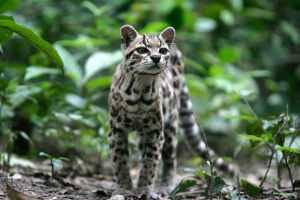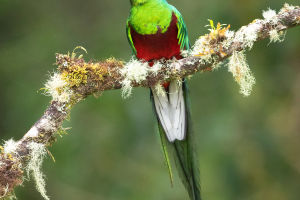
We guess most of us haven't, and that's okay! The margay is a mysterious little wild cat living deep in the tropical forests of Central and South America.
Imagine a small jungle cat that moves like a ninja in the treetops and has those wide, shining eyes like a fairytale character. Curious now? Let's dive into their world together.
They're born for the trees
Margays spend most of their lives up in the trees. From Mexico down to Argentina, these cats live in thick forests where they sleep, hunt, and even raise their young up high. Unlike most cats, margays can run down trees headfirst, thanks to their flexible ankles that can rotate 180 degrees! That means they don't just climb trees—they practically own them.
What do margays look like?
If you've seen an ocelot, you're close! Margays look quite similar but are a bit smaller. They have soft brown or yellowish coats, decorated with dark spots and patches that help them blend into the leafy shadows. Their bodies are about 1.5 to 2.5 feet long, and they carry a long tail—almost as long as their body—which helps them balance as they leap between branches.
They've got “Kitty in Boots” eyes
Seriously, one look into their huge round eyes and you'll understand why people can't stop staring. Those eyes aren't just cute—they're powerful tools for hunting at night. Since margays are mostly active in the dark, their sharp night vision is key to spotting dinner.
What's on the menu?
Margays aren't picky. They'll eat small animals like monkeys, birds, lizards, frogs, and even fruit or eggs if they find them. A study in 2007 found that they eat at least 19 different types of food! Instead of chasing after prey, margays often sit quietly and wait for the right moment to pounce—classic ambush style.
Can they talk like monkeys?
Believe it or not, yes. Researchers in the Amazon heard margays mimicking the cries of small monkeys to lure them closer. When curious monkeys came to investigate, the margay would suddenly strike. That's next-level jungle trickery!
They're part of a big cat family
Margays belong to the same cat family as big wild cats like cougars—even though margays weigh only about 6–8 pounds. They're in the same group as ocelots and oncillas too. In fact, people often think of margays as mini ocelots.
They're not crowd lovers
Margays are loners. Aside from mating, they usually avoid others, living solo in their forest homes. After mating, the male moves on, and the female raises her kittens by herself. It takes a year for a kitten to grow up, and two to three years before they're old enough to have babies of their own.
Spots for life
Even as babies, margays already have their signature spots. Their fur is covered in leopard-like patterns from day one, helping them blend in with the forest as soon as they're born.
They don't like ocelots nearby
Because ocelots are larger and stronger, margays tend to avoid areas where ocelots live. This has even been given a name—the “ocelot effect.” Sadly, it forces margays into smaller and less ideal habitats where food is harder to find.
They're hard to find
Margays are super shy and their population is pretty low. On average, only about 1 to 5 margays live in every 100 square kilometers. That's why sightings are so rare. Some reports say they might've lived in Texas long ago, but there's no solid evidence they're still around in the U.S.
Sadly, their numbers are falling
In the 1980s and 1990s, margays were hunted illegally—mainly for their beautiful fur. Today, that's no longer allowed, but their biggest threat is habitat loss. Forests are being cleared for farming and roads, and that means fewer homes for margays. Experts believe their population may drop by 30% in the next two decades.
They're not great in captivity
Unfortunately, margays don't do well in zoos or breeding programs. Only about half of the kittens survive past two years in those settings, so conservation efforts need to focus more on protecting their wild homes instead of trying to raise them in enclosures.
How do margays flirt?
When a female margay is ready to mate, she lets out a low groan to signal nearby males. The males respond with high-pitched trills and even do a little “mating dance” by shaking their heads quickly. Who knew wild cats could be such performers?
So, what can we do?
The best way to help margays is by protecting their forest homes. Supporting rainforest conservation, learning about wildlife, and avoiding products that come from deforested land can all make a difference. These cats may be small, but their role in the forest is huge.
Let's wrap it up, Lykkers!
Isn't it wild how much mystery and magic can live up in the trees? Margays are more than just beautiful—they're smart, agile, and full of surprises. So next time you look at a tree, imagine a little spotted cat running headfirst down the trunk or mimicking a monkey's call. Nature is full of hidden wonders—and now you know one of them!
Want more amazing animal stories like this one? Let us know which wild creature you'd like to explore next!


